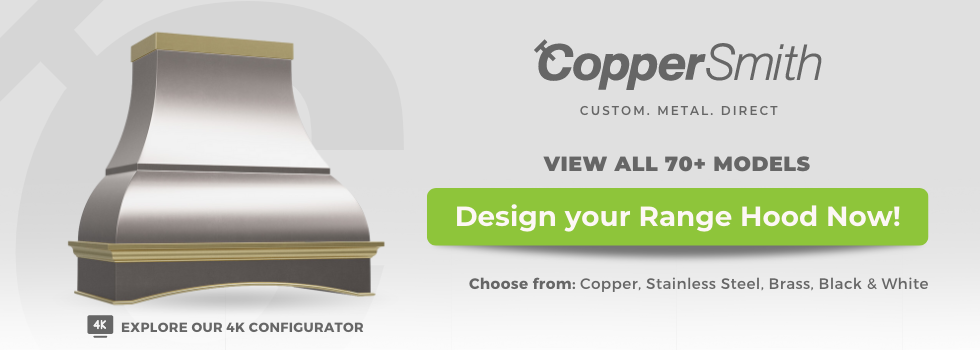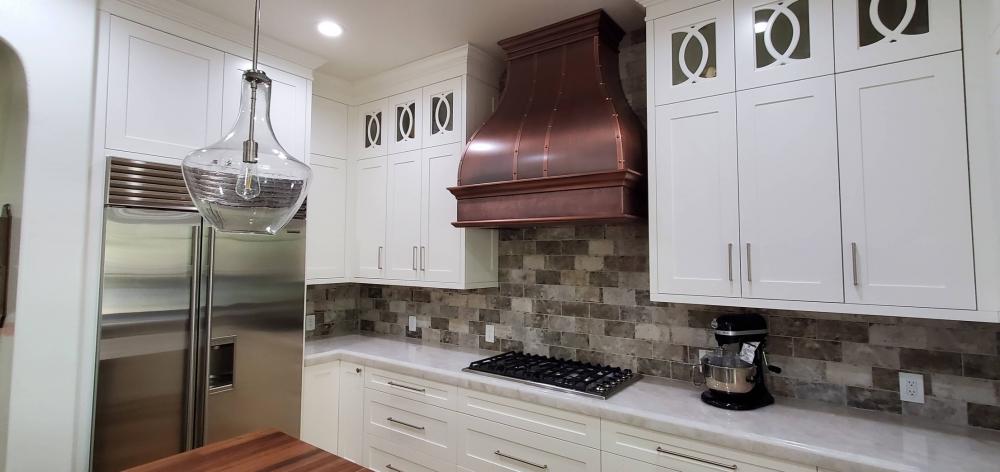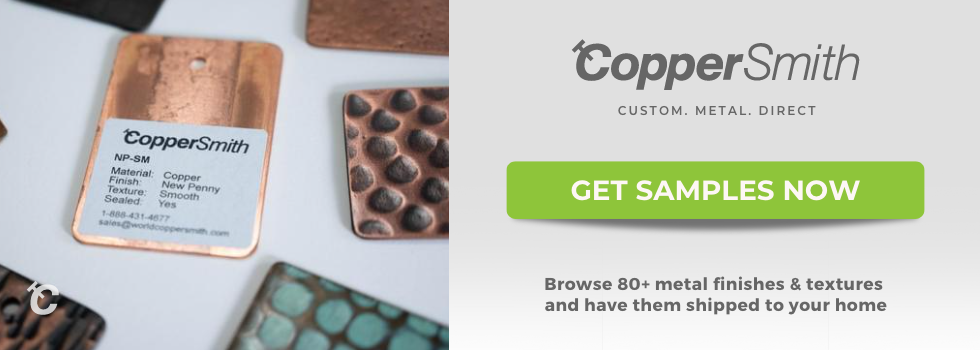
When it comes to designing your kitchen space, it's all about finding a way to blend functionality with aesthetics while being mindful of your budget. One element often overlooked during kitchen upgrades is the range hood cover, despite its status as one of your home's major appliances.
A custom hood’s size gives it major potential for instantly pulling a room together, particularly custom-made pieces with unique designs and bespoke materials. But with so many options- from traditional stainless to striking nickel silver- how do you decide which is best for your kitchen?
What Is a Range Hood Cover?
A kitchen range hood cover is the outer structure of your vent hood and is more important than most homeowners realize. That piece of hardware above your stove keeps your home's air clean and cool by funneling smoke, heat, and cooking odors into the fan-powered equipment that vents the contaminated air outside
Without it, something as simple as a boiled-over pot or oil drip on the oven coils could cause overwhelming amounts of debris to choke you out of the kitchen in seconds. Custom hood covers are also the perfect canvas for creating a kitchen centerpiece that will make you the envy of any houseguest who happens to catch a glance at your kitchen. There's a whole world of hood cover materials to explore beyond the stainless steel options available in big box stores, and we're going to walk you through a few of our favorites.
What Is the Best Material for a Hood?
Most range hoods are metal because it offers durability and performance in even the most heavily-used kitchens. However, if you're looking for something different for your custom hood, we have insights on two alternatives that make for equally eye-catching showpieces.
Copper
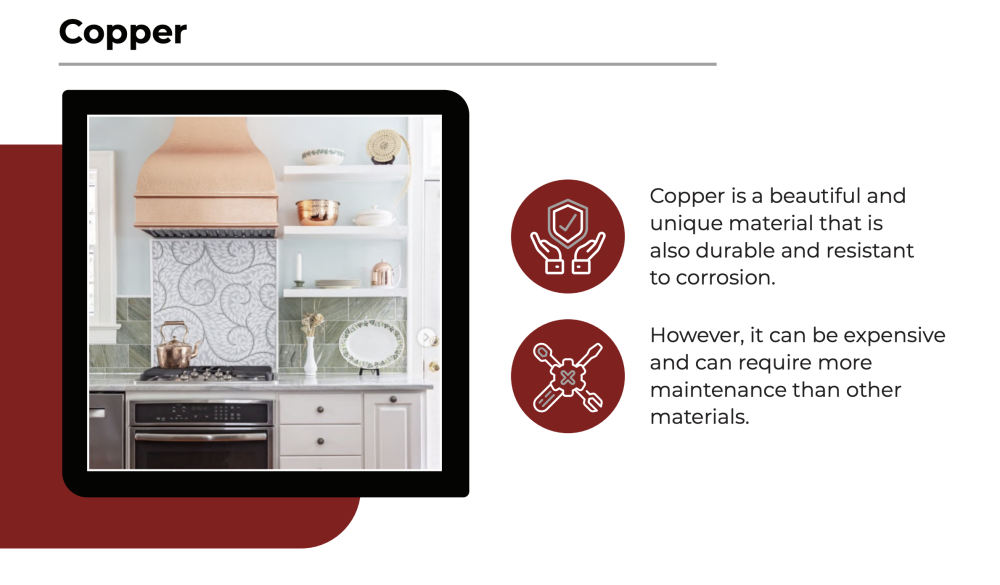
Copper is naturally-occurring, pure metal that man has used since the New Stone Age.
Copper range hood covers are excellent heat conductors, making them ideal for kitchens where heavy cooking occurs. They are highly durable and corrosion-resistant, ensuring your investment lasts many years without deterioration. Copper's antibacterial properties are an added advantage, helping maintain a hygienic cooking environment.
Aesthetically, copper's reddish-brown color exudes a rustic warmth and gets even better over time. As this ancient metal ages, it develops a beautiful patina, or a natural coating caused by oxidation, that adds even more color depth to an already stunning material.
One thing to consider is that copper requires regular polishing to maintain its original luster. However, its durability and beauty make it a worthwhile investment for those seeking a distinctive kitchen centerpiece.
Stainless Steel

Stainless steel, an alloy combining iron, chromium, nickel, and other elements, is one of the more popular choices for range hood covers because of its affordability. Renowned for its strength and corrosion resistance, stainless steel is sleek and modern. It can make kitchens feel larger and brighter because its high shine reflects light throughout the space.
It's also a practical choice, as it can withstand high temperatures and is resistant to staining. Cleaning stainless steel is relatively easy, requiring a mild detergent and a soft cloth. However, it's prone to visible fingerprints and smudges unless coated. While stainless steel range hood covers might appear cold or clinical in certain design schemes, their heat resistance and easy maintenance make them a practical choice for many homeowners.
Bronze
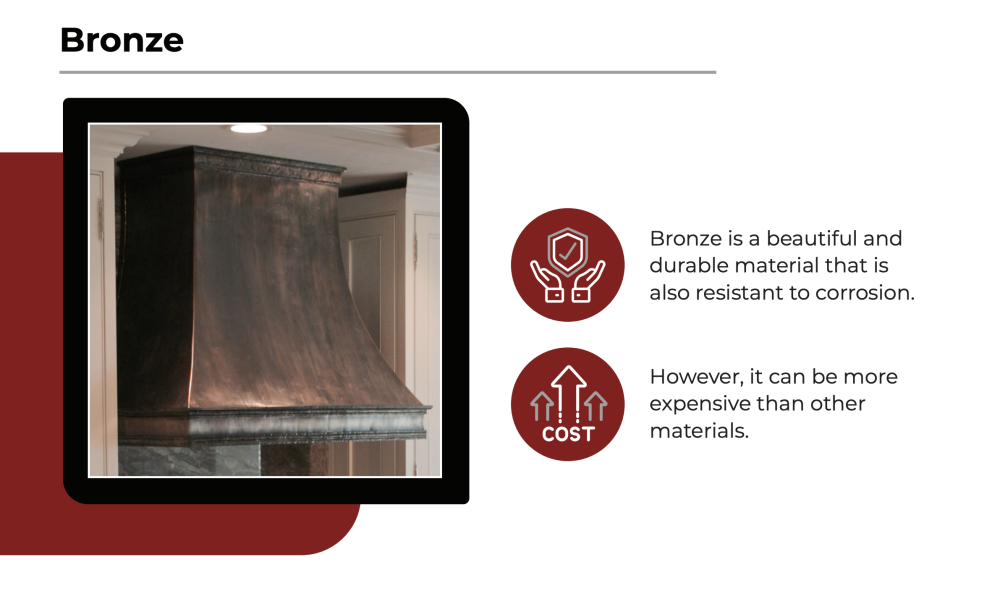
Bronze is a sturdy alloy made primarily from copper, resulting in a rich, warm color. Depending on the proportion of each metal, it can range from soft golden to a darker chocolate brown. Bronze range kitchen hood covers can bring a traditional charm to a kitchen, especially as it ages. Like copper, bronze develops a patina over time but requires regular care to maintain its shine and prevent tarnishing.
Bronze range hood covers can be more expensive than those made from other metals. However, most homeowners who choose bronze would agree the price tag is well worth brass's incredible longevity and ability to withstand the rigors of a busy kitchen without warping.
Zinc
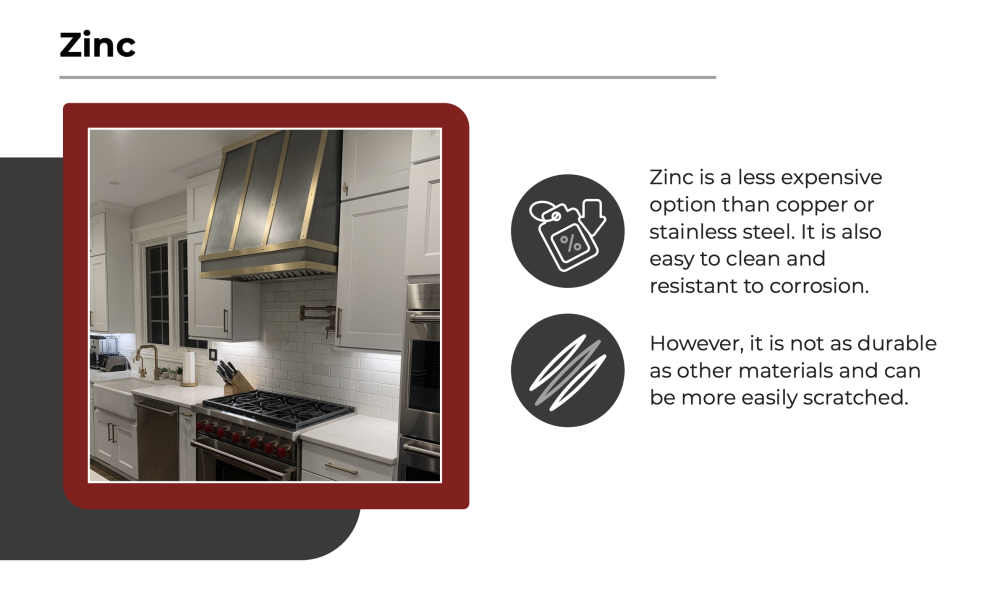
Zinc range hood covers are notable for their eye-catching, bluish-white shine and corrosion resistance. They have a distinctly industrial look, similar to that of old stovepipes. This unique custom hood material is highly long-lasting and can withstand high temperatures, making them ideal for heavy cooking environments. Zinc also doesn't rust, so moisture from steam need not be a concern.
Over time, zinc develops a soft, gray patina, adding a layer of visual interest and additional protection against corrosion. One downside to zinc range hoods is that they can scratch easily, so if it's what you choose for your home, take care during cleaning. It's also more expensive than some other materials. Still, its enduring and distinctive icy sheen makes it a natural statement piece choice for those seeking something unique for your vent hood.
Nickel Silver
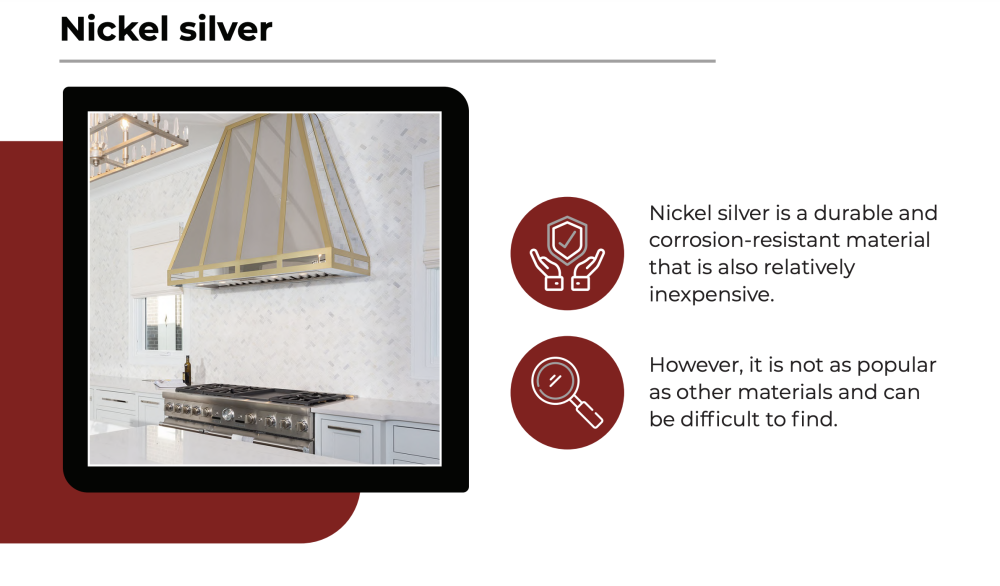
Nickel silver, or German silver, is a copper alloy with nickel and sometimes zinc. Despite its name, it doesn't contain any silver. Nickel silver range hood covers provide a bright, silvery appearance that gives your kitchen space a sleek, modern look that pair well with granite countertops.
This alloy is strong, corrosion-resistant, and retains its luster over time, making it a natural choice for range hoods. It can also handle high temperatures and resists staining but requires regular polishing to maintain its shine. Nickel silver is more expensive than stainless steel but offers a brighter and more luxurious sheen, making it a worthy consideration for those seeking an elegant kitchen ambiance.
Tempered Glass
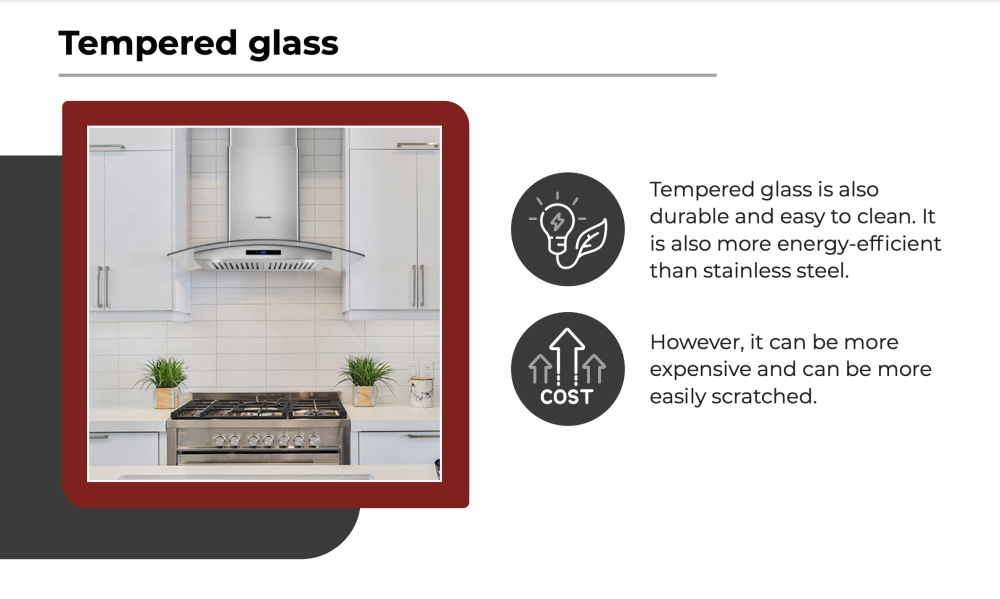
Tempered or safety glass undergoes heat and chemical treatments to increase strength compared to ordinary glass.
For range hoods, tempered glass offers a sleek, contemporary aesthetic that can visually lighten a kitchen's appearance. It allows for a brighter view of the cooking area and can work beautifully in modern or minimalist designs. The transparency of the glass can also enhance the sense of space in smaller kitchens.
Tempered glass is heat resistant and won't be damaged by high cooking temperatures. Cleaning is straightforward, with glass cleaning agents efficiently removing grease and grime.
However, a glass range hood may show smudges and fingerprints more readily than other materials, so frequent cleaning might be required. Additionally, while tempered glass is much stronger than standard glass, it can still shatter under severe impact.
Despite these considerations, tempered glass's stylish appeal and easy maintenance make it a popular choice for modern kitchen designs.
Wood
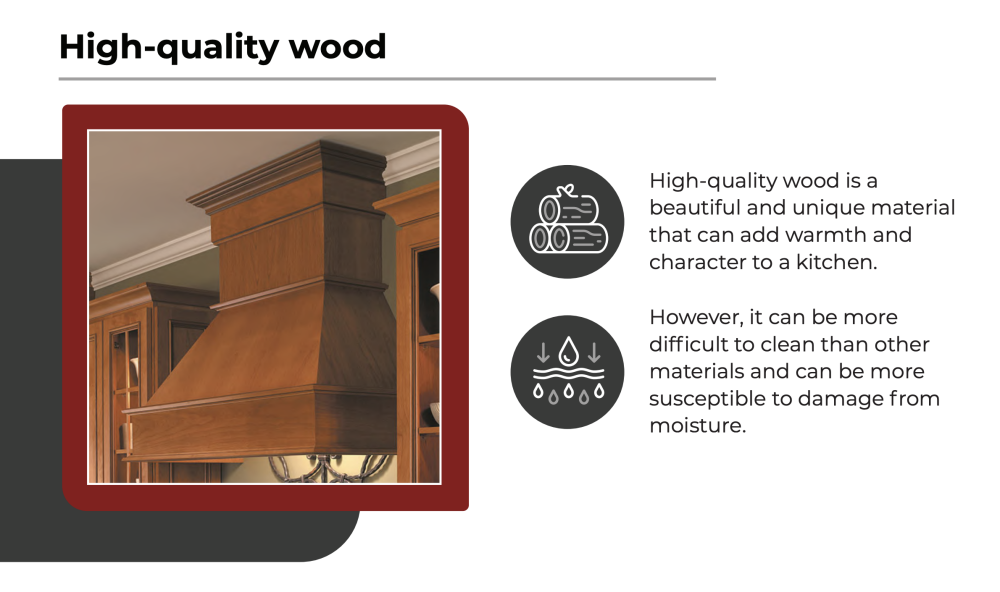
Wood offers a traditional aesthetic that can make a kitchen feel cozy and welcoming. With a wide variety of wood types and finishes available, the possibilities are endless for creating custom wooden range hoods tailored to your tastes.
Depending on the finishing touches you choose, they can also suit any kitchen design, from rustic to modern.
Wood is a good insulator compared to metal's high conductivity, meaning it won't become too hot to the touch during cooking. However, the wood must be adequately sealed and finished to protect it from moisture, heat, and grease that can cause damage over time. Regular cleaning and maintenance, including resealing, are necessary to preserve its appearance in the long term.
You'll need to give your ventilation and ductwork a close inspection before installing a wood range hood cove, as wood is not as heat-resistant as metals. When properly cared for, a wood custom hood can be a beautiful focal point in a kitchen, providing a warmth and charm that few other materials can match.
How Do I Choose a Range Hood Cover?
There's a lot to think about before you pick your perfect range hood cover, but our handy guide can walk you through the process:
Material
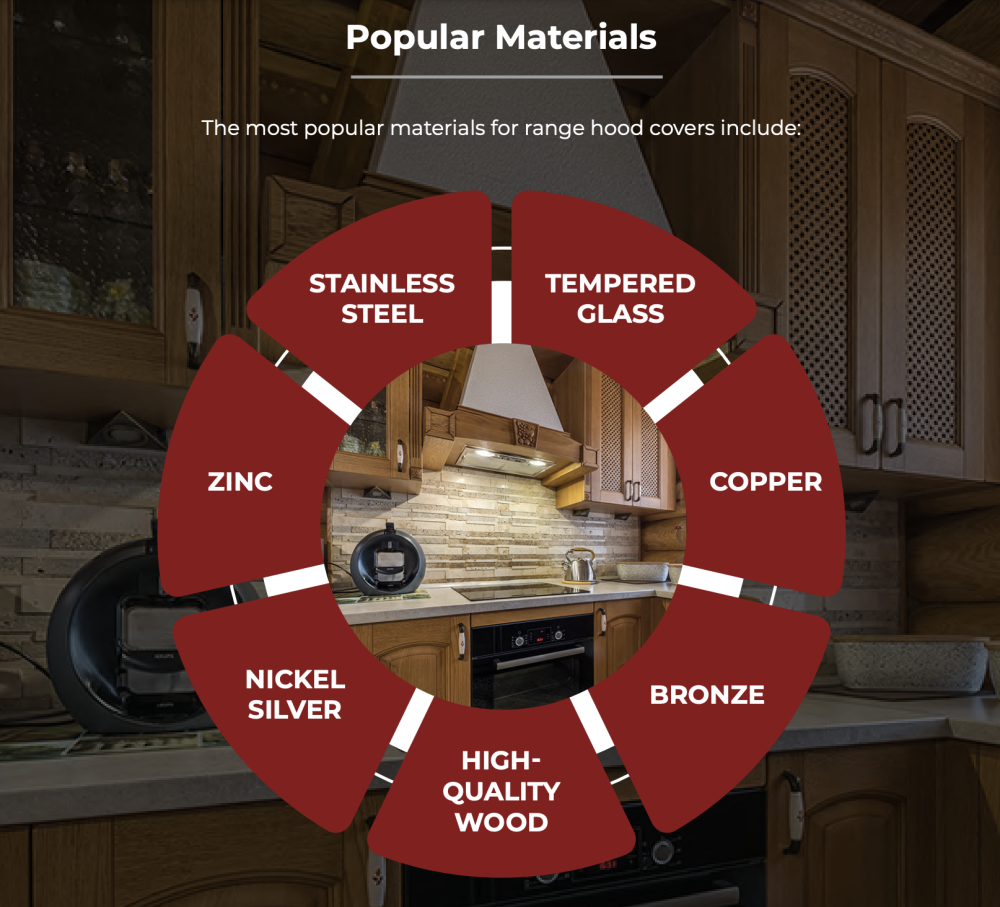
The material you choose for your range hood cover is the most significant factor in its appearance, price, and maintenance requirements. For example, a stainless steel or tempered glass range cover might be ideal if you're angling for a sleek, modern look or working with a smaller budget, but they require more frequent cleaning. If you'd prefer something with an antique finish, copper and bronze tarnish beautifully, but they're more expensive.
Size
Your custom hood should be 6 inches wider than your cooktop surface, extending 3 inches on either side of your stove and outward to at least the middle of the front burners. Otherwise, you risk letting smoke and food particles escape before they can reach the fans and taxing the motor if it's too small to keep up with your full-range cooking style.
Shape
Choose a custom range hood cover shape that complements the kitchen design.
Soft curves like those on our Artisan AT8 hood covers add a touch of Parisian charm, while the sharply angled geometry of Designer DS1 is gorgeously minimalistic.
Crown Profile
The crown profile or the 'trim' is the transition point between the hood range cover and ceiling.
Some hoods have ornate, detailed trims with swoops and dips, while others have more modern, sloped profiles.
It's yet another customizable element that you can use to tell your kitchen decor's story through your hood vent cover.
Finish
The finish of your kitchen range hood cover can drastically alter its appearance:
- Hand-hammered, hard-hammered, and soft-hammered finishes add texture and a rustic appeal to metal range hoods.
- Polished finishes give your new range hood a sleek, glossy look, perfect for modern or contemporary kitchens.
- Smooth finishes provide a clean, minimalist aesthetic.
- Coated finishes for stainless steel add protection against fingerprints and smudges.
Motifs
Motifs are decorative designs, from delicate florals to bold geometric shapes. Check out our design catalog to see more than 50 motif examples.
Rivets and Straps
Add contrasting or coordinating straps and rivets to your range hood for an elegant finishing touch. Low-profile rivets and straps are subtle and blend in with the hood, while hammered and pyramid-styles add texture.
Efficiency
The hood should effectively capture smoke, grease, and odors. Look for a range hood insert with good suction power, measured in cubic feet per minute (CFM). A higher CFM means a more powerful exhaust system, which is particularly important if you cook frequently or use high-heat cooking methods.
Sound Level
Range hoods can be noisy, especially at higher fan speeds. Consider a range hood insert that operates quietly if you're sensitive to noise. Some manufacturers provide sound-level information, often in sones, on their product specifications. The lower the sone number, the quieter the hood.
Installation Type
Consider the installation type that will work best for your kitchen layout. Under-cabinet hoods are installed beneath kitchen cabinets and are a great space-saving option. Wall-mounted hoods are installed against a wall, while island hoods are for kitchens with an island cooktop. Your kitchen's design will largely determine the most suitable installation type.
Ventilation Type
Kitchen range hoods can be ducted (vented) or ductless (recirculating). Ducted hoods require a duct system to vent the air outside, but they are more efficient at removing heat, smoke, and odors. Ductless hoods draw air through a filter and then return it to the kitchen. They're easier to install, but the filters require regular cleaning or replacement.
Features
Modern, custom range hoods have various features, including heat sensors that automatically adjust fan speed and built-in lighting.
Frequently Asked Questions
We've answered two of our customers' most commonly asked questions about range hoods below:
Can you cover a stainless steel range hood?
Yes, you can cover a stainless steel range hood. You can order a custom cover large enough to fit over your existing hood, so long as the shell doesn't interfere with the venting functions and can withstand the heat generated by your cooktop.
What is the best duct material for range hoods?
Rigid galvanized or stainless steel ducts with non-textured interiors are the best duct materials for range hoods. They're heat-resistant, durable, and less likely to accumulate grease than plastic and semi-rigid ducts.
They also comply with most local building codes, which typically discourage or prohibit plastic ducts for range hoods because they accumulate grease over time, creating a fire hazard.
Closing the Hood: Final Thoughts
From the choice of material to the intricate details of finish, motifs, and shape, each element of your custom range hood cover helps define your kitchen's character. We hope our guide serves as a helpful resource for finding a cover that seamlessly complements your kitchen while efficiently serving its purpose.


